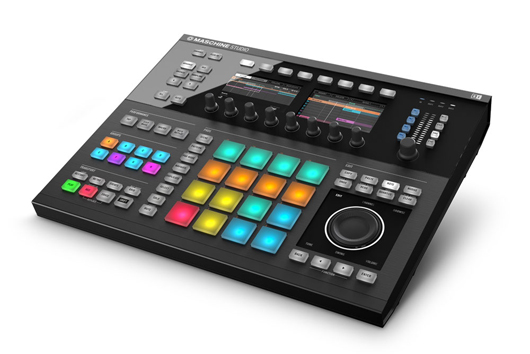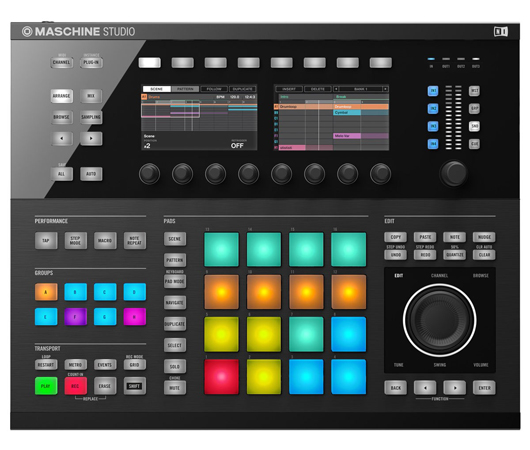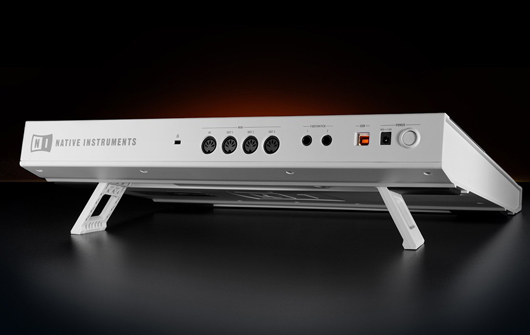Review: Native Instruments Maschine Studio
Maschine Studio is the new, flagship product in Native Instruments‘ popular MPC-style “groove production studio” […]

Maschine Studio is the new, flagship product in Native Instruments‘ popular MPC-style “groove production studio” line, outfitted with onboard screens and a host of new controls. Included in the box is the brand-new Maschine 2.0 software, which is a big leap forward, full of features and tweaks large and small. Whether you invest in the Studio hardware or not, the 2.0 software is an essential upgrade, and works across the entire range of existing controllers: the original Maschine and Maschine Mikro, as well as their Mk II equivalents.

How It Looks
In many ways, Maschine Studio feels like using a classic drum machine workstation (read: ASR, MPC, EPS, etc). The larger size now accommodates two OLED displays, marking a big step beyond NI’s previous controller screens. Browsing through your library of Native Instruments sounds is much improved, with the various knobs and screens used to dial in on the style of sound you want by filtering through tags. Arranging and sequencing patterns can now be done without looking at your computer screen at all; the left display provides an overview of the scenes and patterns in the timeline, while a closer, more detailed view populates the right display, ordered by name and color.
Maschine Studio makes use of NI’s new Maschine 2.0 software, and the GUI switches between what’s now known as the “Arrange” and “Mix” views. Though there’s no built-in audio interface, mixing is improved by the Studio hardware as well. In addition to the virtual mixer viewable on the Studio’s displays, a Master section on the upper right portion of the unit is outfitted with an LED level meter that can be switched to show the volume at the master, or of individual groups or sounds. This is also where the incoming sound from Maschine’s four stereo inputs can be monitored, which serves as a boon to the software’s prodigious sampling capabilities. Finally, an Edit section incorporates a large, clickable jog wheel that will become the primary means of scrolling and selecting. This section will be used to transpose/nudge notes, as well as to adjust volume, swing and tempo.

How It Sounds
One of Maschine 2.0’s finest new features—and one that itself entirely justifies the $99 upgrade fee without buying the Studio hardware—is the set of new drum synthesizers. Essentially, these are five dedicated drum and percussion synth plugins (Kick, Snare, Hi-Hat, Tom, and Percussion), each of which offers a host of ‘engines’ and custom-tailored controls. They sound fantastic, ranging from purely digital to strikingly realistic, and are exceptionally easy to use. From room-filling 808 sub-harmonics to more tom variations than we could shake a shaker at, their frequency-shaping possibilities are endless.
Sidechaining is now fully supported in Maschine 2 for VST/AU plugins and its own Compressor, Limiter, Gate, Filter, and Maximizer effects. This makes it very easy to set up sidechain compression on the fly, without so much as having to look away from the controller. The Sample Editor can now produce slices that overlap and have gaps between them, and macros are now unlimited, and can now be assigned targets from the Master, Group, and Sound levels. Undo now comes in two forms: Step Undo (i.e. classic undo) and Take Undo—the former of which allows for undo-ing a note at a time, while the latter can undo the last set of actions as a group. There are now unlimited Groups, Scenes, and plugins available, and the Follow mode is greatly appreciated.
The Bottom Line
It’s clear that software integration with Maschine Studio will evolve over time. The screens, for instance, don’t yet feel like they’ve been fully taken advantage of; rather than merely providing numerical readouts of affected variables on a particular virtual device, for instance, we’d love to see fully visualized, animated representations thereof. The graphics (particularly those representing the NI sound packs) feel a bit dated, and certain commands aren’t as clear as they could be. Generally, the 2.0 software still lacks the ability to record and transmit MIDI CC to control external gear, as well as time-stretched audio.
But these are small quibbles, and because they’re software-based, improvements stand a good chance of appearing in future updates. If the upgrade to Studio seems like a no-brainer, then it probably is. There are hundreds of minor workflow improvements that the expanded controller enables, and it’s possible to go for longer stretches of time than ever without even glancing at the computer screen—staying in the zone, so to speak. The pads are incredibly bouncy and sensitive, and smart inclusions like the kickstand-style feet built into the bottom of the unit make for superb ergonomics. As was perhaps evident upon first glances of the photos of the hardware online, Maschine Studio is some seriously luxurious beat-making kit.
MSRP: $999

